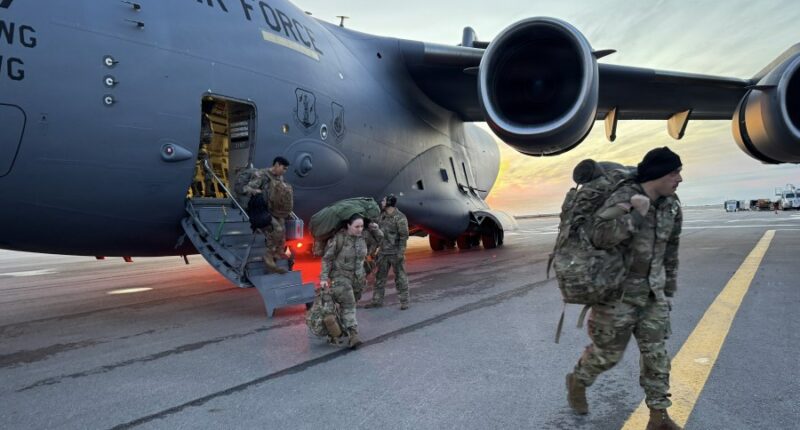Share this @internewscast.com

ANCHORAGE, Alaska (AP) — It felt like an earthquake had hit as the house started swaying, then suddenly it was adrift. Water began to trickle through the front door, while waves pounded against the large glass window.
In the sole dry room, Alexie Stone found refuge with his brothers and children, peering outside to see a scene reminiscent of an aquarium. A shed floated dangerously close, threatening the window, but mercifully diverted before causing damage.
The house eventually settled just feet from its original position, halted by another building in its path. Despite this, the house and much of Stone’s Alaska Native village of Kipnuk remain unlivable after a massive storm surge inundated parts of western Alaska. The disaster claimed one life, left two people missing, and triggered a significant evacuation, flying over 1,000 residents to safety.
“In our village, we pride ourselves on being Native strong, and nothing usually breaks us. But this has been our toughest challenge,” Stone shared on Thursday, standing outside the Alaska Airlines Center in Anchorage, where he and hundreds of others are currently sheltered. “Everyone is looking out for each other in there. We’re grateful that we’re all alive.”
The aftermath of Typhoon Halong brought unprecedented water levels to the low-lying Alaska Native communities last weekend, sweeping away homes, some with residents still inside. Makeshift shelters quickly became home to about 1,500 people, a significant number for a region accessible only by air or sea at this time of year.
Initially, many evacuees were transported to Bethel, a regional hub of 6,000 residents. However, as shelters reached capacity, authorities worked to relocate them. Stone and his family spent several nights in the Kipnuk school library before being flown to Bethel and then on to Anchorage, roughly 500 miles (805 kilometers) east of the villages. They arrived strapped into the floor of a massive military transport plane, alongside hundreds of other evacuees.
Another military plane carrying evacuees was due to arrive at Joint Base Elmendorf-Richardson on Thursday evening.
Two villages were hit hard
The hardest-hit communities, Kipnuk and Kwigillingok,saw water levels more than 6 feet (1.8 meters) above the highest normal tide line. Some 121 homes were destroyed in Kipnuk, a village of about 700 people, and in Kwigillingok, three dozen homes drifted away.
Cellphone service had been restored in Kwigillingok by Thursday, authorities said, and restrooms were again working at the school there, where about 350 people had sheltered overnight Tuesday.
Damage was also serious in other villages. Water, sewer and well systems were inoperable in Napaskiak, according to a statement from the Federal Emergency Management Agency.
Jeremy Zidek, a spokesperson with the state emergency management office, said he did not know how long the evacuation would take and said authorities were looking for additional shelters. The aim is to get people from congregate shelters into hotel rooms or dormitories, he said.
The crisis unfolding in southwest Alaska has drawn attention to Trump administration cuts to grants aimed at helping small, mostly Indigenous villages prepare for storms or mitigate disaster risks.
For example, a $20 million U.S. Environmental Protection Agency grant to Kipnuk, which was inundated by floodwaters, was terminated by the Trump administration, a move challenged by environmental groups. The grant was intended to protect the boardwalk residents use to get around the community, as well as 1,400 feet (430 meters) of river from erosion, according to a federal website that tracks government spending.
Determined to rebuild
While still in Kipnuk, Stone spent his days trying to help out, he said. He would make trips to the airport to pick up water or food that had been sent by other villages, and deliver it to the school. He worked to help rebuild the boardwalks on which residents get around. And when he had time, he would return to his battered house, trying to clean up some of the waterlogged clothing and electronics the floodwaters had tossed about.
But the damage is extensive. Fuel and stove oil leaked from tanks, and the odor of petroleum permeates the entire town, he said. Like other villagers in the region, his family lost stores of food intended to help them get through the winter — the refrigerator and three freezers full of halibut, salmon, moose and goose.
Stone’s mother, Julia Stone, is a village police officer in Kipnuk. She was working at the school last weekend when the winds suddenly picked up, people suddenly began arriving at the building, and her on-call police cellphone begin ringing with calls from people in need – some reporting that their houses were floating.
She tried to reach search and rescue teams and others to determine if there were available boats to help, but the situation was “chaos,” she said.
Her voice broke during an interview Thursday in Anchorage as she thanked those at the school who helped with the response. “It’s a nightmare what we went through, but I thank God we are together,” she said.
Stone said he evacuated with the clothes on his back. Most of the rest of what he owned was soaked and reeked of fuel. The Red Cross provided cots, blankets and hygiene supplies in Anchorage, he said, and he went out to a thrift store on Thursday to get more clothes: two shirts, a sweater, two pairs of pants, and tennis shoes.
He is not sure when it might be safe to return to Kipnuk.
“Everybody here that came from Kipnuk, they’re pretty strong,” Stone said. “If we have to start over, we have to start over.”
___
Johnson reported from Seattle. Associated Press writer Becky Bohrer in Juneau contributed.

















